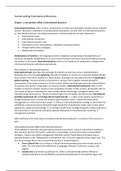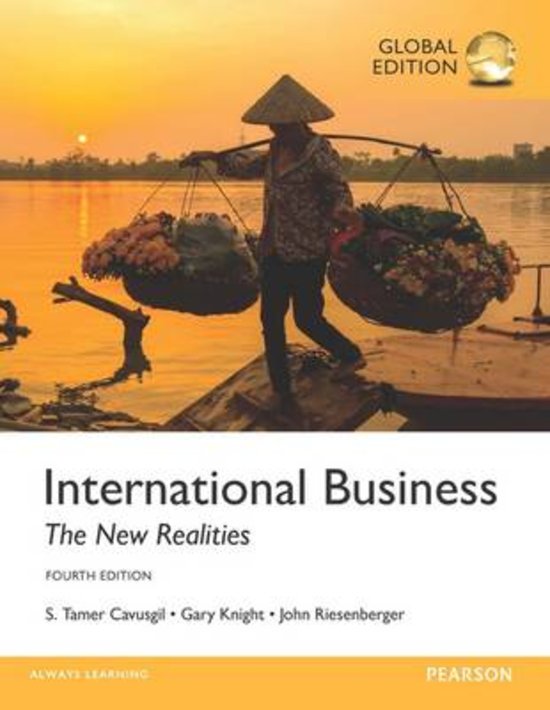Samenvatting International Business
Chapter 1. Introduction: What is International Business?
International business refers to firms’ performance of trade and investment activities across national
borders. Because it emphasizes crossing national boundaries, we also refer to international business
as cross-border business. International business is characterized by six major dimensions:
• International trade;
• International investment;
• International business risks;
• Participants; firms, intermediaries, facilitators and governments;
• Foreign market entry strategies;
• Globalization of markets.
Globalization of markets is the ongoing economic integration and growing interdependency of
countries worldwide. Globalization is a macro-trend of intense economic interconnectedness among
the nations of the world. Internationalization refers to the tendency of companies to deepen their
international business activities systematically.
Key concepts in international business
International trade describes the exchange of products and services across national borders.
Exchange can occur through exporting, the sale of products or services to customers located abroad
from a base in the home country or a third country. Exchange can also take the form of importing or
global sourcing – the procurement of products or services from suppliers located abroad for
consumption in the home country or a third country. While exporting represents the outbound flow
of products and services, importing is an inbound activity. International investment refers to the
transfer of assets to another country or the acquisition of assets in that country. Economists refer to
such assets as factors of production; they include capital, technology, managerial talent, and
manufacturing infrastructure. The two essential types of cross-border investment are: international
portfolio investment (1) and foreign direct investment (2). 1 = refers to the passive ownership of
foreign securities such as stocks and bonds to gain financial returns. It does not entail active
management or control over these assets. 2 = (FDI) an internationalization strategy in which the firm
establishes a physical presence abroad through acquisition of productive assets such as land, plant,
equipment, capital and technology. It is a foreign-market entry strategy that gives investors partial of
full ownership of a productive enterprise typically dedicated to manufacturing, marketing, or
management activities.
GDP is defined as the total value of products and services produced in a country in the course of a
year.
International business differs from domestic business
Firms operate in countries characterized by distinctive economic, cultural, and political conditions.
Not only does the firm find itself in unfamiliar surroundings, it encounters many uncontrollable
variables – factors over which management had little control. These factors introduce new or
elevated business risks. Globalization is not without risks. Firms are exposed to four major risks. The
firm must manage these risks to avoid financial loss or product failures:
• Cross-cultural risk: occurs when a cultural misunderstanding puts some human value at
stake. This risk arises from differences in language, lifestyles, mind-sets, customs, and
religion.
• Country risk: also known as political risk, refers to the potentially adverse effects on
company operations and profitability caused by developments in the political, legal, and
, economic environment in a foreign country. Includes the possibility of foreign government
intervention in firms’ business activities.
• Currency risk: also known as financial risk, refers to the risk of adverse fluctuations in
exchange rates. Fluctuation is common for exchange rates – the value of one currency in
terms of another. This risk arises because international transactions are often conducted in
more than one currency.
• Commercial risk: refers to the firm’s potential loss or failure from poorly developed or
executed business strategies, tactics, or procedures.
Who participates in international business?
International business requires numerous organizations, with varying motives, to work together as a
coordinated team, contributing different types of expertise and inputs. There are four major
categories of participants:
• A focal firm is the initiator of an international business transaction; it conceives, designs, and
produces offerings intended for consumption by customers worldwide. Focal firms take
center stage in international business. There are primarily large multinational enterprises
(MNE’s) and small and medium sized enterprises (SME’s).
• A distribution channel intermediary is a specialist firm that provides various logistics and
marketing services for focal firms as part of international supply chains, both in the focal
firm’s home country and abroad.
• A facilitator is a firm or an individual with special expertise in banking, legal advice, customs
clearance, or related support services that helps focal firms perform international business
transactions. A freight forwarder is a specialized logistics service provider that arranges
international shipping on behalf of exporting firms.
• Governments, or the public sector, are also active in international business as suppliers,
buyers and regulators.
Whereas focal firms, intermediaries, and facilitators represent the supply side of international
business transactions, customers or buyers make up the demand side. Customers consist of:
• Individual consumers and households;
• Retailers;
• Organizational buyers.
A multinational enterprise (MNE) is a large company with substantial resources that performs
various business activities through a network of a subsidiaries and affiliates located in multiple
countries. Small- and medium-sized enterprises (SMEs) are manufactures or service providers with
fewer than 500 employees. In the EU they are defined as having fewer than 250 employees.
Compared to large multinationals, SMEs can be more flexible and quicker to respond to global
business opportunities. One type of contemporary international SME is the born global firm, a young
entrepreneurial company that initiates international business activity very early in its evolution,
moving rapidly into foreign markets. The emergence of born globals is associated with international
entrepreneurship, in which innovative, smaller firms pursue business opportunities everywhere,
regardless of national borders.
Why do firms internationalize?
There are many motives for international expansion, some strategic in nature, other reactive:
• Seek opportunities for growth through market diversification;
• Earn higher margins and profits;
• Gain new ideas about products, services, and business methods;
• Serve key customers better that have relocated abroad;
, • Be closer to supply sources, benefit from global sourcing advantages, or gain flexibility in
product sourcing;
• Gain access to lower-cost or better-value factors of production;
• Develop economies of scale in sourcing, production, marketing, and R&D;
• Confront international competitors more effectively or thwart the growth of competition in
the home market;
• Invest in a potentially rewarding relationship with a foreign partner;
At the broadest level, companies internationalize to enhance competitive advantage and find growth
and profit opportunities.
Chapter 2. Globalization of markets and the internationalization of the firm
Globalization of markets refers to the gradual integration and growing interdependence of national
economies. Globalization allows companies to outsource value-chain activities to the most favorable
locations worldwide. Globalization has also made it easier for companies to sell their offering
worldwide.
Phases of globalization
Third fase → establishment of the World
Trade Organization (WTO). This is a
multilateral governing body empowered to
regulate international trade and investment.
The WTO aims to regulate and ensure fairness
and efficiency in global trade and investment.
Firms expand abroad proactively to increase
sales and profit through new markets, find
lower-cost inputs, or obtain other
advantages. Firms may also internationalize
reactively because of unfavorable conditions
in the home market such as regulation or
declining local industry sales.
The figure on the other page makes a distinction between:
• Drivers or causes of globalization;
• Dimensions or manifestation of globalization;
• Firm-level consequences of globalization;
• Societal consequences of globalization.
Drivers of globalization
• Worldwide reduction in barriers to trade and investment; the tendency of national
governments to reduce trade and investment barriers has accelerated global economic
integration.
• Market liberalization and adoption of free markets;
• Industrialization, economic development, and modernization; economic development results
in increased incomes and living standards.






